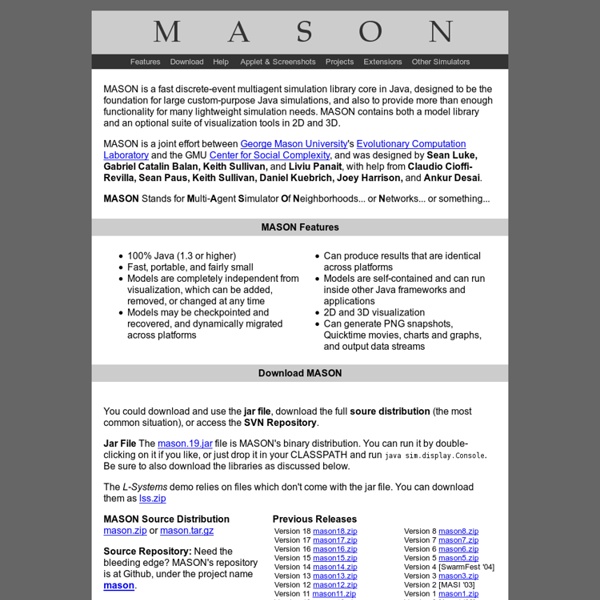NetLogo Home Page
NetLogo is a multi-agent programmable modeling environment. It is used by tens of thousands of students, teachers and researchers worldwide. It also powers HubNet participatory simulations.
The SIM_AGENT Package
The University of Birmingham School of Computer ScienceThe Cognition and Affect Project Aaron Sloman Slide Presentation on SimAgent Demonstration movies NOTE ON FORMATTING: Adjust the width of your browser window to make the lines of text the length you prefer.
Home
Simplify your research! Plan your research project with the help of SAGE Research Methods. With SAGE Research Methods, faculty, students, and researchers can: Learn how to design a research project Discover new methods to use in your research with the Methods Map Read over 175,000 pages of SAGE's renowed research methods content from leading global authors Browse content from over 720 books, dictionaries, encyclopedias, and handbooks Share content with colleagues and research partners using Methods Lists Explore related online journal content with the SAGE Journals widget Watch a video that answers key questions about research methods
ECJ
ECJ is a research EC system written in Java. It was designed to be highly flexible, with nearly all classes (and all of their settings) dynamically determined at runtime by a user-provided parameter file. All structures in the system are arranged to be easily modifiable. Even so, the system was designed with an eye toward efficiency.
100 Search Engines For Academic Research
Back in 2010, we shared with you 100 awesome search engines and research resources in our post: 100 Time-Saving Search Engines for Serious Scholars. It’s been an incredible resource, but now, it’s time for an update. Some services have moved on, others have been created, and we’ve found some new discoveries, too.
The breve Simulation Environment
What is breve? breve is a free, open-source software package which makes it easy to build 3D simulations of multi-agent systems and artificial life. Using Python, or using a simple scripting language called steve, you can define the behaviors of agents in a 3D world and observe how they interact. breve includes physical simulation and collision detection so you can simulate realistic creatures, and an OpenGL display engine so you can visualize your simulated worlds.
Mill's Methods
Mill's Methods are five methods of induction described by philosopher John Stuart Mill in his 1843 book A System of Logic.[1] They are intended to illuminate issues of causation. The methods[edit] Direct method of agreement[edit] If two or more instances of the phenomenon under investigation have only one circumstance in common, the circumstance in which alone all the instances agree, is the cause (or effect) of the given phenomenon.
Complex systems
Complex systems present problems both in mathematical modelling and philosophical foundations. The study of complex systems represents a new approach to science that investigates how relationships between parts give rise to the collective behaviors of a system and how the system interacts and forms relationships with its environment.[1] Such systems are used to model processes in computer science, biology,[2] economics, physics, chemistry,[3] and many other fields. It is also called complex systems theory, complexity science, study of complex systems, sciences of complexity, non-equilibrium physics, and historical physics. A variety of abstract theoretical complex systems is studied as a field of mathematics. The key problems of complex systems are difficulties with their formal modelling and simulation.
Basic Business Research Methods
Organizations use research, especially in market research activities. Market research is used to identify potential markets, the needs and wants of each, how those needs and wants can be met, how products and services could be packaged to be most accessible to customers and clients, the best pricing for those products and services, who the competitors are and how best to complete against each, potential collaborators and how to collaborate with each -- and many other applications of research. Organizations can conduct this research without having to have advanced skills.
Multi-agent system
Simple reflex agent Learning agent Concept[edit]
Research Methods
Research methods is a broad term. While methods of data collection and data analysis represent the core of research methods, you have to address a range of additional elements within the scope of your research. The most important elements of research methodology expected to be covered in business dissertation at Bachelor’s, Master’s and PhD levels include research philosophy, research approach, methods of data collection, sampling and ethical considerations. Let’s look briefly at each of them separately.
Why You Should Be Glad That Quadrotors Have Learned to Dodge Swords
When that quadrotor fencing video showed up everywhere last month, we asked Ross Allen, the Stanford PhD candidate (and fencer) responsible for the research, if he’d be willing to talk to us about it. He said sure, except his thesis defense was that Friday, so would we mind waiting a bit? It’s been a bit, and after a successful defense, Dr. Allen is somehow not sick and tired of robots and answered a bunch of our questions about quadrotors, swords, and why mixing them is such a great idea. Here’s the video that you (and a couple hundred thousand other people) probably saw a few weeks ago:



